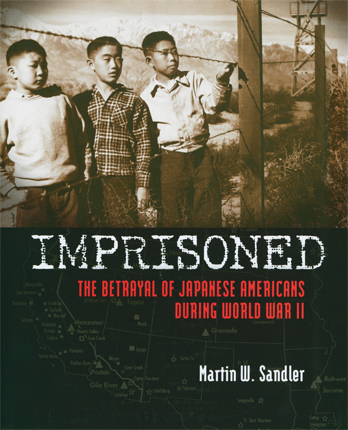Full Text Reviews: Bulletin for the Center... - 07/01/2013 Racial prejudice, nativist resentment over immigrant business success, and wartime panic—each was a poisonous element in itself, and combined they led to Executive Order 9066, which mandated the relocation and virtual incarceration of some 120,000 Japanese-American citizens and Japanese residents loyal to the United States. Rapid announcement and enforcement of the order impelled the internees to liquidate personal and business assets at stupefying financial loss and to pack their few remaining possessions in preparation for relocation to unknown destinations. While many settled stoically into crude, makeshift accommodations in the relocation camps, others eager to prove their dedication to their adopted country would take up arms for the national defense. Although this shameful episode in American history receives considerable attention in both fiction and information books for youth, Sandler probes into aspects of the story less often covered in work that focuses narrowly on the camps themselves. Here readers learn about Quaker protests against Japanese internment, similar camps in Central and South America, Nisei WACs and interpreters working for the American Armed Forces, generational differences regarding the redress movement, and current Japanese-American collaborations with the Muslim community in support of a group too often viewed as suspect. Cogently organized and heavily illustrated with photographs, with an index, source notes, and lists for “further reading and surfing,” this will be a valuable title in the American History collection. EB - Copyright 2013 The Board of Trustees of the University of Illinois. School Library Journal - 08/01/2013 Gr 7 Up—Sandler expertly crafts a narrative that manages to explain the horror and incomprehensibility of locking up American citizens in prison camps simply because of their ethnic ancestry. Japanese American relocation has long been expurgated from school history texts about World War II, and here this delicate topic is handled with sensitivity and insight, providing an in-depth look at the full story, from anti-Japanese sentiments during the first wave of immigration through more current issues such as redress. A close examination of both the nation's feelings after the attack on Pearl Harbor and the political conversations that followed is an important part of the story that leads up to the actual relocation of hundreds of thousands of people. There is also a lengthy and moving section about the young Japanese Americans who served in the military in a variety of capacities, from actual combat to intelligence and translation services. Sandler makes it clear that these brave folks were battling prejudice and tyranny overseas while their families and friends were suffering under it back at home. The irony was not lost on them. Photographs help to further the narrative and yet tell their own story, offering rich detail and putting a human face on this tragic episode. A must-have for any library collection.—Jody Kopple, Shady Hill School, Cambridge, MA - Copyright 2013 Publishers Weekly, Library Journal and/or School Library Journal used with permission. Booklist - 12/15/2013 *Starred Review* Yes, the bombing of Pearl Harbor drew America into WWII. But it also created strong waves of fear and mistrust of Japanese American immigrants in the U.S. and led to their internment in poorly appointed, remote “relocation centers” for the duration of the war. In addition to placing their story within a broader context, Sandler uses apt quotes to introduce readers to individual evacuees and their families, who lost their belongings, yet maintained their dignity during their sometimes humiliating ordeals. The book also documents the loyal service of Japanese Americans in the U.S. military as translators and fighting forces. In the opening scene, Japanese American soldiers, whose families still lived in relocation centers surrounded by barbed wire and armed guards, help liberate prisoners from the Germans’ Dachau concentration camp. The well-organized, clearly written text also fills in the broader history of Japanese immigrants in America, from the first generation, who were often excluded from citizenship, to the activists of the 1960s and 1970s, who demanded a public apology and reparations from the U.S. government for the treatment of their elders during the war. Beautifully illustrated with well-chosen photographs and other documents, this handsome book offers a clear view of an episode in American history that still receives too little focus. - Copyright 2013 Booklist. Loading...
|




